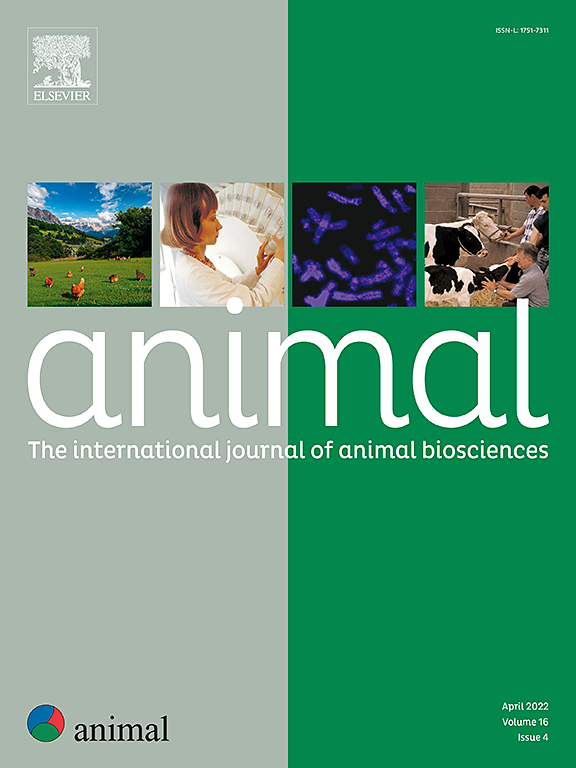苜蓿牧草上的育成期如何影响羔羊肌肉和脂肪的光谱比色特性以及背脂紧实度?
IF 4.2
2区 农林科学
Q1 AGRICULTURE, DAIRY & ANIMAL SCIENCE
引用次数: 0
摘要
牧养羔羊和精养羔羊在肉质和胴体质量性状方面存在许多差异,这些差异可进一步用于追溯日粮,但这些差异在多大程度上受牧养期的影响尚不清楚。在这项研究中,我们调查了羔羊在屠宰前不同时间段(0、21、42、63 天)从以精料为基础的厩饲转为以苜蓿为基础的放牧后,胸长肌和腰长肌肌肉和脂肪的光谱比色特性以及背侧脂肪硬度的变化。来自不同处理组的厩饲羔羊被分到一个组进行管理,来自不同处理组的苜蓿放牧羔羊也被分到一个组共同放牧。为了保持苜蓿牧草喂养羔羊和人工饲养羔羊之间相似的平均生长模式,对人工饲养羔羊的精料喂养量进行了调整。试验连续两年共使用了 141 只羔羊。即使是最短的育成期(21 天),在苜蓿牧场育成的羔羊背脂也更坚实,这种差异具有重要的商业价值。背脂颜色和类胡萝卜素含量在苜蓿牧场饲养21天时发生了变化,但在苜蓿牧场饲养时间较长的情况下,背脂颜色和类胡萝卜素含量没有进一步变化。相反,肾周脂肪的亮度、黄度、色度和类胡萝卜素含量在苜蓿牧场上生长21天时发生了变化,并随着苜蓿牧场休牧时间的延长而持续增加。虽然肉眼无法或几乎无法观察到脂肪光谱色度特性的这些变化,但它们可能有助于鉴定苜蓿放牧时间的长短。肌肉的红度随着苜蓿放牧时间的延长而增加,从苜蓿放牧42天开始,这种变化变得明显,肉眼可以看到。我们观察到,肌肉色调角和肾周脂肪红度随着苜蓿放牧时间的延长而持续下降,肾周脂肪色调角则持续上升,但这些变化只有在苜蓿放牧63天后才变得显著。因此,羔羊胴体和肉质性状的变化模式随苜蓿放牧时间的长短而不同。本文章由计算机程序翻译,如有差异,请以英文原文为准。
How does finishing duration on lucerne pasture influence the muscle and fat spectro-colorimetric properties and dorsal fat firmness in lambs?
There are a number of differences in the meat and carcass quality traits between pasture-raised and concentrate-raised lambs that may further be used to trace back the diet, but the extent to which these differences are modulated by pasture-finishing duration is unknown. In this study, we investigated the changes in longissimus thoracis et lumborum muscle and fat spectrocolorimetric properties, and dorsal fat firmness, in lambs switched from a stall-fed concentrate-based diet to grazing on lucerne for various durations (0, 21, 42, 63 days) pre-slaughter. Stall-fed lambs from the different treatment groups were managed in a single group and lucerne pasture-finished lambs from the different treatment groups also co-grazed in a single group. The level of concentrate fed to stall-fed lambs was adjusted to maintain a similar mean pattern of growth between lucerne pasture-fed and stall-fed lambs. The trial used a total of 141 lambs over two successive years. Dorsal fat was firmer in lambs finished on lucerne pasture, even for the shortest finishing duration (21 days), the difference being of commercial importance. Dorsal fat colour and carotenoid content showed changes at 21 days on lucerne pasture but did not change further for longer lucerne pasture-finishing durations. In contrast, perirenal fat lightness, yellowness, chroma and carotenoid content showed changes at 21 days on lucerne pasture and increased consistently with lucerne pasture-finishing duration. Although these changes in fat spectrocolorimetric properties were not, or barely, visible to the naked eye, they could be of interest for authenticating the duration of lucerne pasture-finishing. Muscle redness increased consistently with the duration of lucerne pasture-finishing, the change becoming significant from 42 days on lucerne pasture and being visible to the naked eye. We observed a consistent decrease in muscle hue angle and perirenal fat redness and a consistent increase in perirenal fat hue angle with lucerne pasture-finishing duration, but these changes only became significant from 63 days on lucerne pasture. The pattern of change in the lamb carcass and meat quality traits measured according to lucerne pasture-finishing duration therefore varied between the tissues and quality traits.
求助全文
通过发布文献求助,成功后即可免费获取论文全文。
去求助
来源期刊

Animal
农林科学-奶制品与动物科学
CiteScore
7.50
自引率
2.80%
发文量
246
审稿时长
3 months
期刊介绍:
Editorial board
animal attracts the best research in animal biology and animal systems from across the spectrum of the agricultural, biomedical, and environmental sciences. It is the central element in an exciting collaboration between the British Society of Animal Science (BSAS), Institut National de la Recherche Agronomique (INRA) and the European Federation of Animal Science (EAAP) and represents a merging of three scientific journals: Animal Science; Animal Research; Reproduction, Nutrition, Development. animal publishes original cutting-edge research, ''hot'' topics and horizon-scanning reviews on animal-related aspects of the life sciences at the molecular, cellular, organ, whole animal and production system levels. The main subject areas include: breeding and genetics; nutrition; physiology and functional biology of systems; behaviour, health and welfare; farming systems, environmental impact and climate change; product quality, human health and well-being. Animal models and papers dealing with the integration of research between these topics and their impact on the environment and people are particularly welcome.
 求助内容:
求助内容: 应助结果提醒方式:
应助结果提醒方式:


